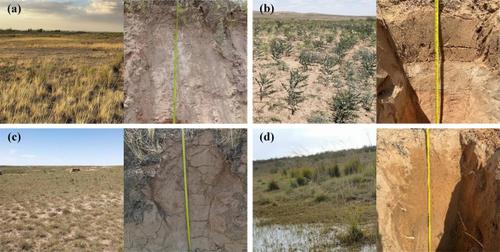当前位置:
X-MOL 学术
›
Ecol. Indic.
›
论文详情
Our official English website, www.x-mol.net, welcomes your feedback! (Note: you will need to create a separate account there.)
Precipitation and plant community-weighted mean traits determine total transpirable soil water in a desert grassland
Ecological Indicators ( IF 6.9 ) Pub Date : 2024-03-16 , DOI: 10.1016/j.ecolind.2024.111873 Juan Chen , Naiping Song , Xing Wang , Chen Meng , Yi Zhang , Lin Chen , Qixue Wang , Hao Lv , Xudong Wu , Dian Yu
Ecological Indicators ( IF 6.9 ) Pub Date : 2024-03-16 , DOI: 10.1016/j.ecolind.2024.111873 Juan Chen , Naiping Song , Xing Wang , Chen Meng , Yi Zhang , Lin Chen , Qixue Wang , Hao Lv , Xudong Wu , Dian Yu

|
The desert grassland has low precipitation, high evaporation and a limited soil water supply. Thus the tension between water shortage and sustainable vegetation restoration is increasingly evident. Change in total transpirable soil water (TTSW) reflects the water utilization and extraction capacity of plant communities, which are the basis for maintaining productivity and stability in communities, as well as the key ecological processes alleviating the above tension. Change in TTSW is influenced by precipitation, vegetation and soil. Quantifying the relative contribution of these factors to change in TTSW is key to the sustainable restoration of desert grassland. However, the current understanding of such effects remains limited. This study examined four typical plant communities in the Ningxia desert grassland, monitoring soil water content and evaluating plant community characteristics and diversity over three consecutive years. Using redundancy analysis and hierarchical partitioning methods, the influence of annual precipitation, vegetation (functional and species diversity, community characteristics) and soil physical properties on TTSW variation were investigated. Findings revealed: (1) The factors contributing to TTSW variation were annual precipitation (41 %-68 %,), vegetation (29 %-45 %), and soil physical properties (0 %-6.7 %). Specifically, community-weighted mean traits (CWM) and functional diversity (FD) explained TTSW variation by 24–37 % and 0.25–11 % respectively. In Gramineae communities, the influence of annual precipitation and vegetation on TTSW variation was consistent across soil depths. However, in degraded + (SA) communities, the influence of vegetation (CWM, FD, community composition and community function) on TTSW variation was more pronounced in shallow soils (45 %) than in deeper soils (33 %), while annual precipitation effects were more substantial in the deep soil layers (66 %) than in the shallow soil layers (42 %). (2) Annual precipitation and CWM were the main biological and abiotic factors affecting TTSW. Interestingly, increased annual precipitation was negatively correlated with TTSW. Similarly, the primary controlling factor, CWM, also showed a significant negative relationship with TTSW. This relationship varied across community types and could be linear or quadratic, highlighting the need to understand the selection effects mediated by CWM in ensuring sustainable vegetation restoration. This research offers insights into the relationship between plant functional diversity and soil water retention function.
中文翻译:

降水量和植物群落加权平均性状决定沙漠草原土壤总蒸腾水
荒漠草原降水量少,蒸发量大,土壤水分供应有限。因此,水资源短缺与可持续植被恢复之间的紧张关系日益明显。土壤总蒸腾水(TTSW)的变化反映了植物群落对水的利用和提取能力,是维持群落生产力和稳定的基础,也是缓解上述紧张的关键生态过程。 TTSW 的变化受到降水、植被和土壤的影响。量化这些因素对 TTSW 变化的相对贡献是荒漠草原可持续恢复的关键。然而,目前对此类影响的理解仍然有限。本研究对宁夏荒漠草原的四种典型植物群落进行了连续三年的土壤含水量监测并评价植物群落特征和多样性。采用冗余分析和层次划分方法,研究了年降水量、植被(功能和物种多样性、群落特征)和土壤物理性质对TTSW变化的影响。研究结果表明:(1)影响TTSW变化的因素有年降水量(41%-68%)、植被(29%-45%)和土壤物理性质(0%-6.7%)。具体来说,群落加权平均特征 (CWM) 和功能多样性 (FD) 分别解释 TTSW 变异 24-37% 和 0.25-11%。在禾本科群落中,年降水量和植被对 TTSW 变化的影响在不同土壤深度上是一致的。然而,在退化+(SA)群落中,植被(CWM、FD、群落组成和群落功能)对TTSW变化的影响在浅层土壤(45%)中比深层土壤(33%)更明显,而年降水量深层土层 (66%) 的影响比浅层土层 (42%) 的影响更大。 (2)年降水量和CWM是影响TTSW的主要生物和非生物因子。有趣的是,年降水量的增加与 TTSW 呈负相关。同样,主要控制因素 CWM 也与 TTSW 呈显着负相关。这种关系因群落类型而异,可能是线性的,也可能是二次关系,强调需要了解 CWM 在确保可持续植被恢复方面所介导的选择效应。这项研究为植物功能多样性与土壤保水功能之间的关系提供了见解。
更新日期:2024-03-16
中文翻译:

降水量和植物群落加权平均性状决定沙漠草原土壤总蒸腾水
荒漠草原降水量少,蒸发量大,土壤水分供应有限。因此,水资源短缺与可持续植被恢复之间的紧张关系日益明显。土壤总蒸腾水(TTSW)的变化反映了植物群落对水的利用和提取能力,是维持群落生产力和稳定的基础,也是缓解上述紧张的关键生态过程。 TTSW 的变化受到降水、植被和土壤的影响。量化这些因素对 TTSW 变化的相对贡献是荒漠草原可持续恢复的关键。然而,目前对此类影响的理解仍然有限。本研究对宁夏荒漠草原的四种典型植物群落进行了连续三年的土壤含水量监测并评价植物群落特征和多样性。采用冗余分析和层次划分方法,研究了年降水量、植被(功能和物种多样性、群落特征)和土壤物理性质对TTSW变化的影响。研究结果表明:(1)影响TTSW变化的因素有年降水量(41%-68%)、植被(29%-45%)和土壤物理性质(0%-6.7%)。具体来说,群落加权平均特征 (CWM) 和功能多样性 (FD) 分别解释 TTSW 变异 24-37% 和 0.25-11%。在禾本科群落中,年降水量和植被对 TTSW 变化的影响在不同土壤深度上是一致的。然而,在退化+(SA)群落中,植被(CWM、FD、群落组成和群落功能)对TTSW变化的影响在浅层土壤(45%)中比深层土壤(33%)更明显,而年降水量深层土层 (66%) 的影响比浅层土层 (42%) 的影响更大。 (2)年降水量和CWM是影响TTSW的主要生物和非生物因子。有趣的是,年降水量的增加与 TTSW 呈负相关。同样,主要控制因素 CWM 也与 TTSW 呈显着负相关。这种关系因群落类型而异,可能是线性的,也可能是二次关系,强调需要了解 CWM 在确保可持续植被恢复方面所介导的选择效应。这项研究为植物功能多样性与土壤保水功能之间的关系提供了见解。



























 京公网安备 11010802027423号
京公网安备 11010802027423号